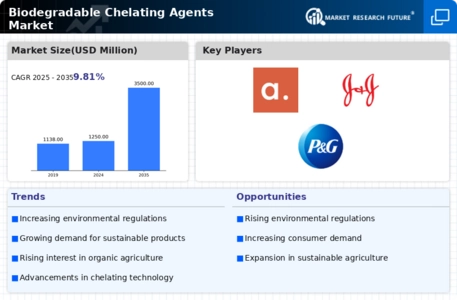Market Analysis
In-depth Analysis of Biodegradable Chelating Agents Market Industry Landscape
Increased demand for environmentally friendly alternatives across different sectors, such as agriculture, water treatment, and household products, has led to significant changes in the market dynamics of biodegradable chelating agents. Chelating agents are compounds capable of forming stable complexes with metal ions, hence inhibiting undesirable reactions and enhancing efficiency within many processes. One factor driving the trends witnessed within this industry globally is a shift towards sustainable practices. The awareness about environment-related problems that cause damage to nature leads to a decreasing ecological footprint and contributes greatly to dynamics' adjustment within the biodegradable chelates marketplace. Long-lasting traditional types like ethylenediaminetetraacetic acid (EDTA) have been proven to persist in the environment and cause issues for water ecosystems. In addition, citric acid, gluconic acid, and amino acids are considered biodegradable alternatives because they are environmentally friendly. In addition to that, the dynamics of the biodegradable chelating agents market are greatly influenced by agriculture. Chelating agents play a very crucial role in agriculture because they improve the availability of essential nutrients for plants while mitigating the harmful effects associated with metal ions present in soils. Biodegradable chelating substances have attracted attention due to their ability to enhance nutrient acquisition while minimizing environmental pollution. The dynamics of the biodegradable chelating agents industry are driven majorly by industrial applications such as the cleaning and detergent industry. They help clean both household and industrial detergents by removing minerals from hard water while making soap more effective at low temperatures. This, therefore, is a way through which manufacturers make products that do not pose a danger to the environment, considering consumer's increasing demand for green or sustainable choices when it comes to housekeeping. However, the biodegradable chelating agents market faces challenges such as cost concerns, performance comparisons, and industry adoption rates. However, some biodegradable alternatives might increase the costs of production compared to traditional chelating agents, making widespread adoption difficult, especially in price-conscious markets. The evolving dynamics of the biodegradable chelating agents market are significantly influenced by research and development activities. Existing efforts, therefore, aim at developing new chelating agents with enhanced biodegradability, efficiency, and cost-effectiveness. Innovations in enzyme-based chelation and green synthesis methods contribute to expanding the range of available biodegradable chelating agents meant for different applications.






Leave a Comment